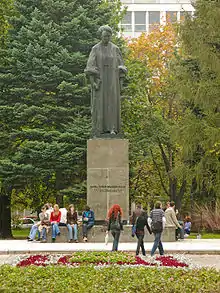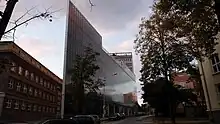Maria Curie-Skłodowska University
Maria Curie-Skłodowska University (MCSU) (Polish: Uniwersytet Marii Curie-Skłodowskiej w Lublinie, UMCS) is a public research university, in Lublin, Poland. It is named in honour of Marie Curie-Sklodowska.
Uniwersytet Marii Curie-Skłodowskiej w Lublinie | |
 | |
| Latin: Universitas Maria Curie-Skłodowska | |
| Type | Public |
|---|---|
| Established | October 23, 1944 |
| Rector | Radosław Dobrowolski |
| Students | 15,785 (2022/2023) |
| Undergraduates | 9,261 |
| Postgraduates | 3,992 |
| Location | , |
| Campus | Urban |
| Affiliations |
|
| Website | www |
The University was founded on October 23, 1944, by the Lublin Committee during the Second World War. Since then, It has expanded to be the largest university in Eastern Poland, with over 12 Faculties in Lublin, and a satellite campus in Puławy. The University has 16,000 students, who study in almost 90 disciplines. This number includes 1,600 international students, who represent over 45 different countries.[1][2]
The University maintains active contacts with foreign research centres, having nearly 200 agreements on scientific and educational cooperation with foreign partners. MCSU also holds 330 Erasmus+ agreements, and a One-Year Preparatory Course for foreigners who wish to study Polish.[1][3]
History
The University of Maria Curie-Skłodowska was founded on October 23, 1944, three months after the Liberation of Lublin by the Red Army. Prof. Henryk Raabe became the first Rector, and would oversee the University till 1948. The first months of the University working were difficult, as due to war shortages, and war damages to the city of Lublin, many of the equipment had to be improvised, and shared. On 3rd of April, 1946, The University was gifted a 17,3 hectare land grant, on (then) outskirts of the city, for the future Campus . That would later be expanded to 80 hectares. 1946 is also the year, when the Botanical Gardens, and the Annales Universitatis Mariae Curie-Skłodowska Journal were created.
Initiallly, the university was made up of four faculties: Medicine, Agriculture, Veterinary Medicine, and Life Sciences. In 1949, Faculty of Law was created. One year later, the faculty of Medicine was excluded, and became the Medical University of Lublin. Similar fate was shared by the faculty of Life Sciences, when in 1955, it became the University of Life Sciences in Lublin. More faculties were created during that time, such as: Mathematics, Physics, Chemistry, Biology, Earth Sciences, Languages, and Economics.
The 1960's and 70's were marked by an expansion of the Lublin Campus. New buildings were created for each of the faculties, the university library was created, along with residences for students, sports hall, and a house of culture Chatka Żaka. Most of these changes were headed by then rector, Grzegorz Leopold Seidler. In 1969, MCSU opened a branch campus in the city of Rzeszów. In 2001, the campus would merge with other institutions of the city, and would go on to become the University of Rzeszów.
Later major changes happened in 1989, and were caused by the fall of communism in Poland. when most of the faculties were reorganized. The last major addition happened in 2014, when a branch campus in Puławy was created. In 2020, three new facilities were opened in Lublin for the Faculty of Political Science and Journalism, and the Institute of Psychology.[3][4]
Reputation
| University rankings | |
|---|---|
| Global – Overall | |
| CWUR World[5] | 1496 (2022) |
| THE World[6] | 1201+ (2022) |
Maria Curie-Skłodowska University holds high academic standards. In 2017 it has been granted the right to display the HR Excellence in Research logo. In 2022 the university joined the prestigious consortium of European Universities - ATHENA (Advanced Technology Higher Education Network Alliance).
According to the Research.com MCSU ranks as 18th best Polish university, and 1534 best in the world. Meanwhile, according to the Webometrics Ranking of World Universities, the university ranks as 23rd best in Poland, out of 408, and 1612 best in the world.
Faculties
- Arts
- Biology and Biotechnology
- Chemistry
- Economics
- Languages, Literatures, and Cultures
- Philosophy and Sociology
- Mathematics, Physics, and Computer Science
- Earth Sciences and Spatial Management
- Education and Psychology
- Political Science and Journalism
- Law and Administration
- Off-Campus Branch in Pulawy
Notable alumni
- Henryk Cioch (1951–2017), lawyer
- Zyta Gilowska (1949–2016), economist and politician
- Stanisław Michalkiewicz (born 1947), politician and activist
- Maciej Płaza (born 1976), writer and translator
- Jarosław Stawiarski (born 1963), politician
- Roman Szporluk (born 1933), Ukrainian and American historian, professor emeritus, doctor of historical sciences
Publications
The university publishes the following journals:[7]
- Acta Humana (ISSN 2082-4459)
- Annales Universitatis Mariae Curie-Sklodowska
- sectio A – Mathematica (ISSN 0365-1029)
- sectio AA – Chemia (ISSN 0137-6853
- sectio AAA – Physica (ISSN 0137-6861)
- sectio B – Geographia, Geologia, Mineralogia et Petrographia (ISSN 0137-1983)
- sectio C – Biologia (ISSN 0066-2232)
- sectio F – Historia (ISSN 0239-4251)
- sectio FF – Philologiae (ISSN 0239-426X)
- sectio G – Ius (ISSN 0458-4317)
- sectio H – Oeconomia (ISSN 0459-9586)
- sectio I – Philosophia-Sociologia (ISSN 0137-2025)
- sectio J – Paedagogia-Psychologia (ISSN 0867-2040)
- sectio K – Politologia (ISSN 1428-9512)
- sectio L – Artes (ISSN 1732-1352)
- sectio M – Balcaniensis et Carpathiensis (ISSN 2450-6354)
- sectio N – Educatio Nova (ISSN 2451-0491)
- Anuario Latinoamericano – Ciencias Políticas y Relaciones Internacionales (ISSN 2392-0343)
- Artes Humanae (ISSN 2449-6340)
- Etnolingwistyka. Problemy Języka i Kultury (ISSN 0860-8032)
- Folia Bibliologica ISSN 1230-2376
- Kultura i Wartości (ISSN 2299-7806)
- Lubelski Rocznik Pedagogiczny (ISSN 0137-6136)
- Lublin Studies in Modern Languages and Literature (ISSN 2450-4580)
- New Horizons in English Studies (ISSN 2543-8980)
- Polish Journal of Soil Science (ISSN 0079-2985)
- Prima Educatione (ISSN 2544-2317)
- Przegląd Prawa Administracyjnego (ISSN 2545-2525)
- Res Historica (ISSN 2082-6060
- Studenckie Zeszyty Naukowe (ISSN 1506-8285)
- Studia Białorutenistyczne (ISSN 1898-0457)
- Studia Iuridica Lublinensia (ISSN 1731-6375)
- TEKA of Political Science and International Relations (ISSN 1896-8279)
- Wschód Europy. Studia humanistyczno-społeczne (ISSN 2450-4866)
- Zeszyty Cyrylo-Metodiańskie (ISSN 2449-8297)
Botanic Garden

Founded in 1946 and originally a part of the campus of the University. In 1951, a new location of the Garden in Sławinek (a district in Lublin) was approved. In 1958, the University obtained the property rights of 13-hectare (130,000 m2) area. It has about 6,500 species of flora growing here, gathered in several area, among others, a rosarium, a branch of water plants and an alpine garden. It also features a reconstructed noble manor house from the second half of 18th century.[8] Between 2012 and 2013, 418 species of moths in total were recorded in the Botanical Garden.[9]
Gallery

_i_Akademia_Rolnicza.jpg.webp) Building of the Department of Humanities
Building of the Department of Humanities.JPG.webp) The Faculty of Polish Philology
The Faculty of Polish Philology View of the Rector's Office
View of the Rector's Office Institute of Information Technology
Institute of Information Technology.JPG.webp) The main building of Marie Curie University as viewed from Sowińskiego St
The main building of Marie Curie University as viewed from Sowińskiego St
References
- "About UMCS". www.umcs.pl. Retrieved 2023-10-25.
- "Podstawowe informacje". www.umcs.pl (in Polish). Retrieved 2023-10-25.
- "Get to know University". www.umcs.pl. Retrieved 2023-10-25.
- "Historia". www.umcs.pl (in Polish). Retrieved 2023-10-25.
- https://cwur.org/2021-22/Maria-Curie-Sk%C5%82odowska-University.php.
{{cite web}}: Missing or empty|title=(help) - https://www.timeshighereducation.com/world-university-rankings/maria-curie-sklodowska-university-umcs.
{{cite web}}: Missing or empty|title=(help) - "Platforma e-czasopism naukowych na UMCS". journals.umcs.pl. Retrieved 25 March 2022.
- "UMCS Botanical Garden of Maria Curie-Skłodowska University / Lublin City Office". lublin.eu. Retrieved 11 June 2021.
- Dawidowicz, Łukasz; Kucharczyk, Halina (January 2016). "The Maria Curie-Skłodowska University Botanical Garden in Lublin as a refuge of the moths (Lepidoptera: Heterocera) within the city". Acta Biologica. 23: 15–34. doi:10.18276/ab.2016.23-02.